In this lesson we are going to be looking at a two-part Invention done by one of my all-time favorite composers: J.S. Bach. You will (should) notice as you work through this piece that Bach is a very melodic player with good chops to boot. Thats what makes this piece so much fun to work through. Its a good technique workout for you intermediate players and its melodic content makes it very fun to learn.
Whats also great about this particular Invention is that a lot of people recognize the melody and I've turned more than a few heads playing this. (Not that its spectacular in terms of technique; people just like the melody). I've heard more than a few Invention #8 ring tones.
Now don't just "kind-sorta" go through this piece. There is a lot to learn here. As I stated earlier, its going to be an alternate picking workout for you intermediate players, but what I want you to pay attention to more is the melodic content: how scale sequences, arpeggios, and motifs are used throughout to create a solid piece of music. Really studying this piece will do a lot to enhance your sense of melody and harmony. Try to pick out the key, scales and arpeggios used as you work through the piece. Memorize and practice until you can play through with no mistakes. That is the true way to learn.
I have only included the main melody to this Invention. I left the harmony out because, unlike the piano, it would be near impossible to play both parts on the guitar. I wanted this to be a performance piece for solo guitar. Perhaps I'll arrange it for two guitars at a later date.

There's a few things I want to draw your attention to:
1) Notice the time signature. Its in 3/4 time. This isn't exactly "Math Music", but can feel a little odd to some players because most of today's music is in 4/4 time.
2) The first measure begins with an eighth note rest. This means you are to begin on the upbeat of the first beat with an upstroke of the pick. I specified picking direction for this first section only. You are to continue the picking trend for the rest of the song unless otherwise stated.
3) Use a metronome. Start at a comfortable speed and slowly bring it up until you hit the target BPM (About 126). Remember, play cleanly! Accuracy before speed every time! Only bring up the tempo when you are 100% comfortable with the setting you are at now.
4) Now I haven't included fingering in this example, but I want you to make use of every finger available to you! Here's a few suggestions:
Use the pinky for the very first note (F on the 5th string), and the index finger for the C on the third string. Let each finger be in charge of a fret and you won't have to shift the position of your hand for the first 4 bars. Students of mine will know of this as the "Finger-Per-Fret" Guideline. Starting with the index finger on the 5th fret, each finger is in charge of a fret. Whenever you play that fret, regardless of what string it is on, you will use that finger. It is impossible to follow the guideline 100% of the time, but it definately makes things a lot easier when you can apply it.
Enough of me talking... here's the rest of part I:
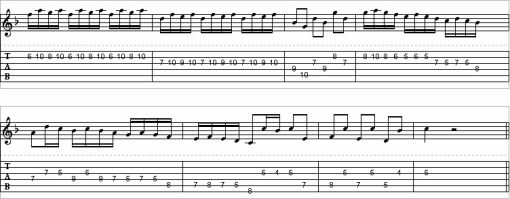
In measure 8, use the middle finger for the high G on the second string and lead off that way: Using the first finger for the F note and then shifting your hand down to use the first finger on the E note.
Careful of the string skipping involved in the second to last measure. Be sure this is smooth and you aren't getting a lot of unwanted string noise, especially if you plan to play this with distortion.
Alrighty... if you are feeling comfortable with part I you can start working on part II:
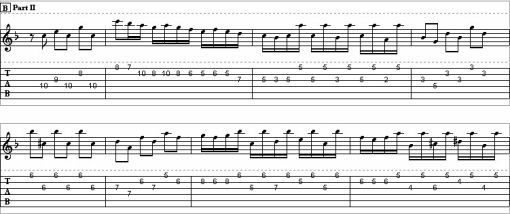
Part II can get a little ugly. It starts off with a familiar melody, but by measure 15 you end up having to deal with a lot of string skipping.
This is how I played it: I used downstrokes of the pick to get the lower melody while using my middle finger to fingerpick the pedal tones (the notes on the high E string). This is easy to do sloppy, especially at 16th notes at 125bpm, so take your time and do it right! By the way, pedal tones are another nifty idea you can work into your solos. A pedal tone is a repeated note, or group of notes in a melody. For the last note of measure 14 I use my ring finger, then slide that same finger to play the 5th fret. This will set you up nicely for the fingerpicking stuff.
And here's the last little bit:
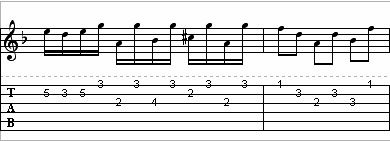
Almost done!
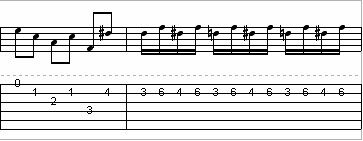
This should be familiar at this point!
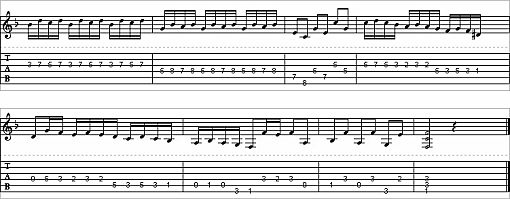
Dan Sorber is a highly respected instructor and guitarist living in the northern New Jersey area.
His teaching approach is based around helping students achieve their goals while making it fun. Dan has been playing for 13 years and teaching for 5.
His influences include Joe Satriani, Iced Earth and Symphony X. Dan currently plays for the melodic progressive metal band, Ferox Canorus.
